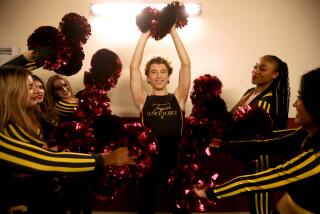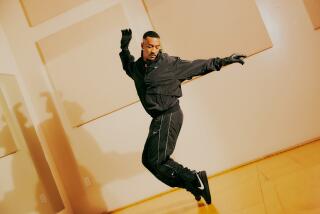
Roni Sagi and her dog Rhythm have always been in sync.
Resting casually on the floor of a production room near the stage of “America’s Got Talent” at the Pasadena Civic Auditorium, Sagi sits for an interview two weeks ahead of her next performance with her 3-year-old black and white border collie. Beneath the spotlight onstage, the two are more than just best friends — they’re also dance partners.
Recently, the pair began working on their upcoming semifinals routine, set to “Flashdance… What a Feeling,” for the popular TV talent competition. Sagi is dressed in her rehearsal clothing, a gray tank top, black stretch pants and white sneakers.
The 32-year-old Israeli is surprisingly relaxed despite the high stakes that await her in front of judges Simon Cowell, Sofia Vergara, Heidi Klum and Howie Mandel. She’s a natural beauty, with her long, sandy blond hair partially tied back accentuating her soulful hazel eyes and infectious smile.
Nearby, Rhythm jauntily greets some of the show’s producers, who pause their work to pet the charming pup. Soon after, he settles at Sagi’s feet, gazes up at her adoringly and then climbs into her lap to lick her face.
The age-old Hollywood maxim never to work with children or animals lest they steal the limelight is undoubtedly true watching Sagi and Rhythm, whose spectacular dance routines on “America’s Got Talent” have scored the duo a spot in the finals this season.
Nothing pleases Sagi more, however, than for Rhythm to be the center of attention.
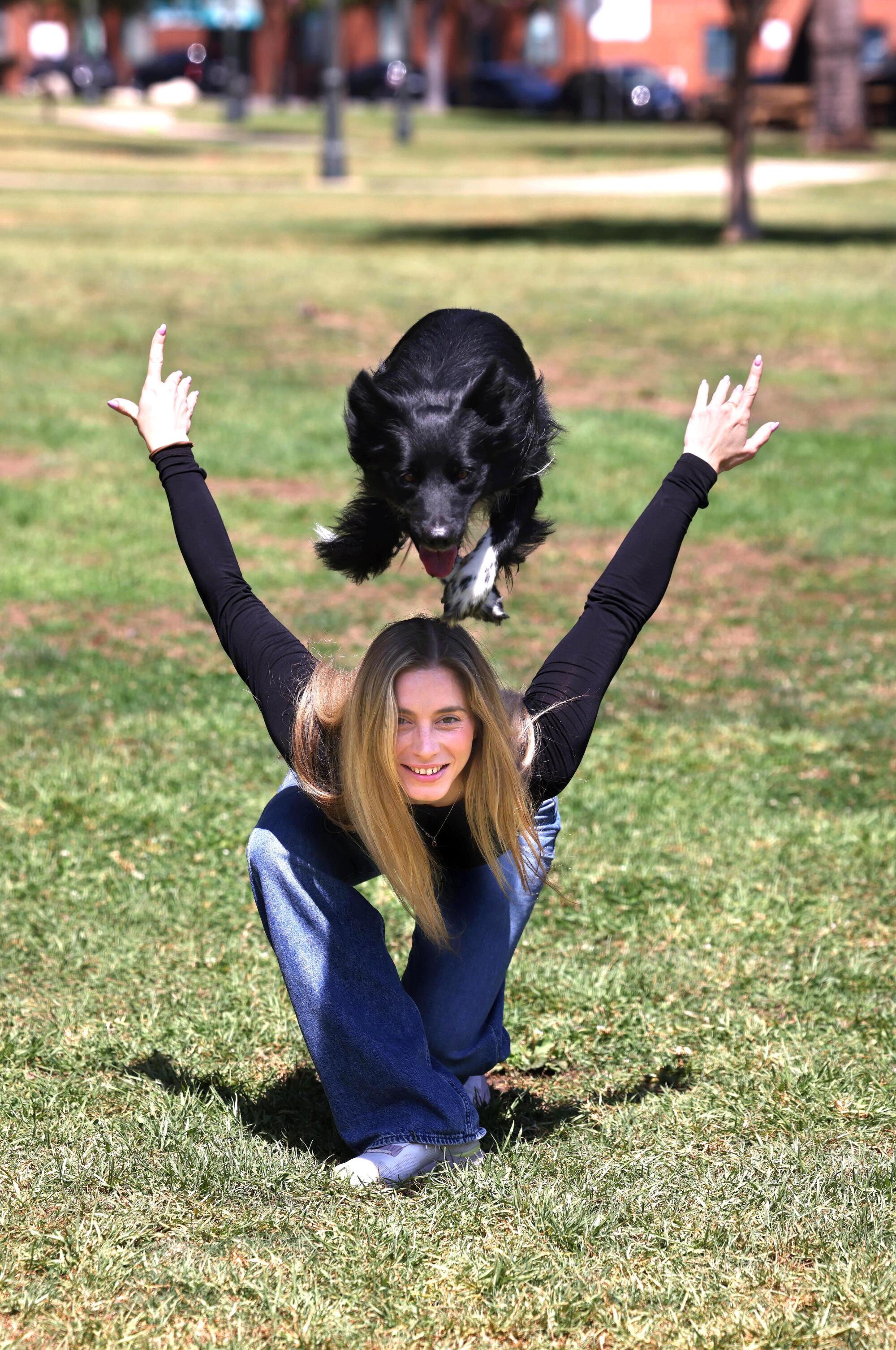
“When I said that Rhythm is going to perform like a dancer, they said, ‘He’s a dog.’ I said, ‘Yes, but I’m aiming for him to look like a dancer when we perform.’”
— Roni Sagi
“We are a team, but if we finish the routine and people aren’t looking at him like he is the star, I didn’t do something right,” she said.
Energetic and highly intelligent, border collies are traditionally bred to be herding dogs. This comes out in Rhythm when he stands up and strides in giant circles around Sagi. “He always does that to me,” she says with a laugh.
Offstage, their affection for one another is as palpable as when they perform together. Along with Rhythm’s remarkable athleticism, agility and dance talent, and Sagi’s grace, the pair’s profound emotional bond elevates their dynamic performances to transcendent.
Even those who are not normally attracted to dog acts are moved. “I’m not a ‘dog person’ and I’m crying. It was beautiful,” reads one comment on a YouTube video of their rousing June audition to Sia’s cover of “California Dreamin’,” which has accumulated 1.6 million views to date.
What’s more, one can’t help but to humanize Rhythm as he dances with Sagi, especially when he performs his “model walk,” which is quickly becoming his trademark — crossing one front paw over the other as he struts forward, dramatically pausing between each step.
“How do we know the dog is a real dog?” Cowell, the show’s notoriously toughest judge, asked after the pair’s electrifying quarterfinals performance to a mash-up of Queen’s “Bohemian Rhapsody” and “Don’t Stop Me Now.”
The perception of Rhythm as a human dance partner is a testament to Sagi’s exceptional skill as a trainer and choreographer.
“My mission is to create the feeling that this is a duet between a human and a human, not a human and a dog,” she says.
“Most times, when you watch a dog dance routine you can see that the handler is in control, leading the dog to do his moves. For me, it is about creating the feeling that the dog knows his role and we can dance freely together so that it can feel more natural when you watch it.”
She attributes her unique approach, which she also teaches through her Keta Tov (Good Vibes) website, to her background in both dancing and dog training.
Sagi and her older sister, Sol, 34, were born in Hong Kong where her father, Moshe, worked as a soccer talent scout. Her mother, Galia, is a musician who also teaches tai-chi, along with self-defense to girls who have suffered from or been exposed to violence. Sagi’s family moved back to Israel when she was about 4. Her parents divorced 20 years ago and she was mostly raised by her mother; her father frequently returned to Hong Kong due to work.
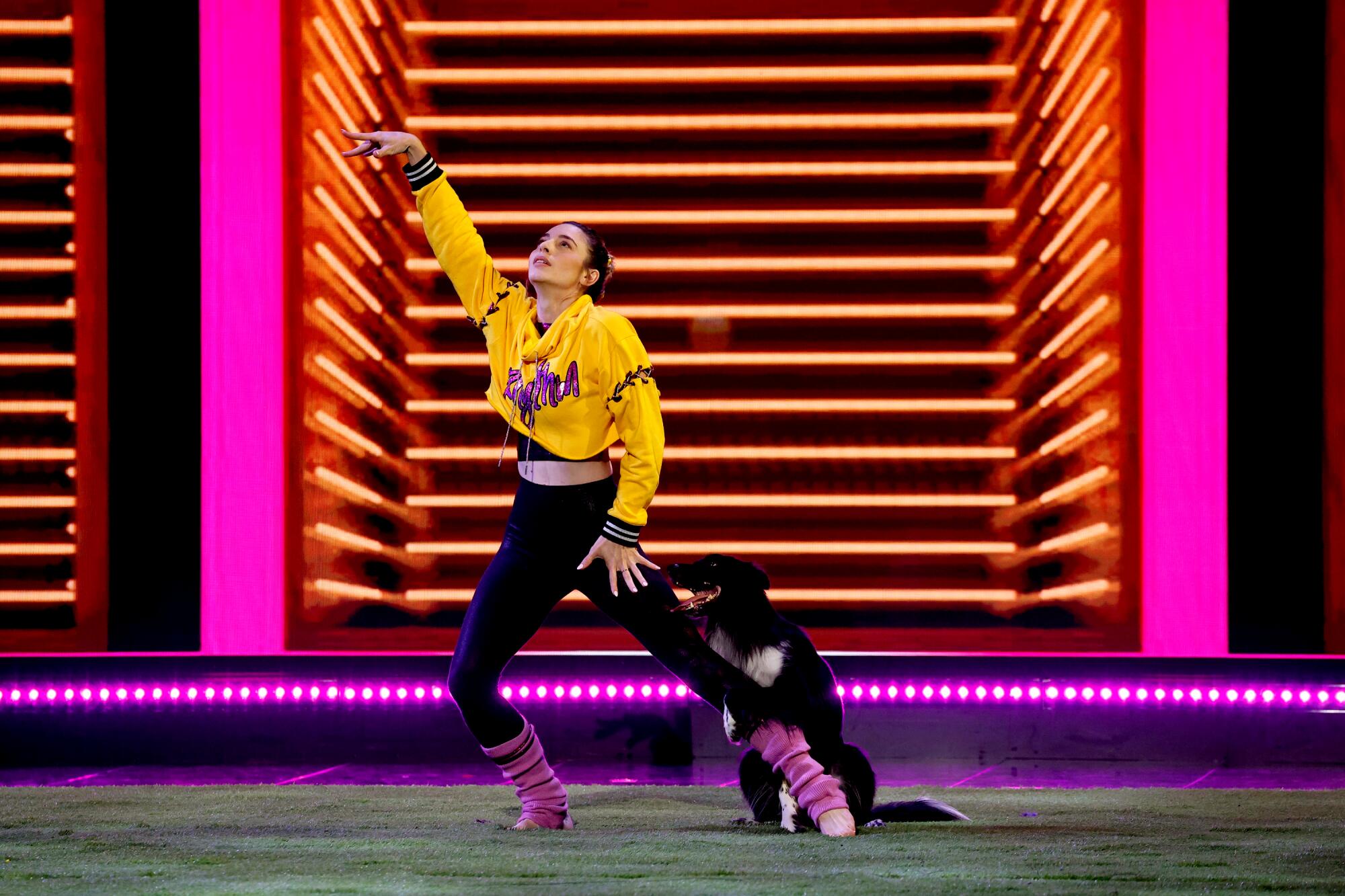
A shy, introverted child, Sagi was more at ease around dogs than humans. When she was 6, she desperately wanted a canine companion, crawling around the house pretending she was a white dog named Snow. Then, one day, her mom brought home a white dog she’d rescued. Later, Sagi added a stray dog, Poppy, to the mix. “Dogs were always my besties,” she says.
But as younger siblings often do, she idolized and wanted to emulate Sol, who was a dancer (she went on to found Sol Dance Academy, a chain of hip-hop studios). Sagi joined a dance group when she was 9 and flourished amid the camaraderie and friendships and won many competitions.
However, during her midteens, Sagi quit after she developed a more consuming interest. “I discovered that there is something called ‘boys’ and I stopped,” she said, laughing.
Then, in her mid-20s, after fostering a pooch with serious behavioral issues, she decided to attend a training school specializing in service and therapy dogs and companion pets.
She was working as a professional dog trainer and competing in dog Frisbee when she discovered her true calling after being awestruck by a video of a freestyle dog dance at the 2014 Open European Championships, a competition dedicated to multiple forms of dog dancing.

“Before I even watched the video, I said, ‘What do you mean you can have a dog and dance together?’” Sagi says. “And then when I watched it, it was the most intense experience of my life. I was like, ‘How did I not know about this until now?’ And I was wondering, ‘Does the dog create the choreography? How is this even possible?’”
She made the transition to dog dancing after taking lessons online in 2019 from renowned dog dancer Anastasiia Beaumont. Soon after, Sagi started her competitive dog dancing journey with Pessah, a rescue border collie she got when he was about 1½. Under her tutelage, he ended up exceeding her expectations, placing third at the Open European Championships in 2022.
However, Pessah’s lack of proper socialization as a puppy left him highly distractible, so Sagi retired him from competition.
“He is incredible but I would never be able to perform with him on the biggest stages because he would not be able to concentrate with all the lights or a camera moving in front of him or too many people in the audience or all the noises and smells,” she says.
Rhythm, however, remains laser-focused amid the challenges of live television, which is also more difficult than a dog dance competition because of the much smaller stage.
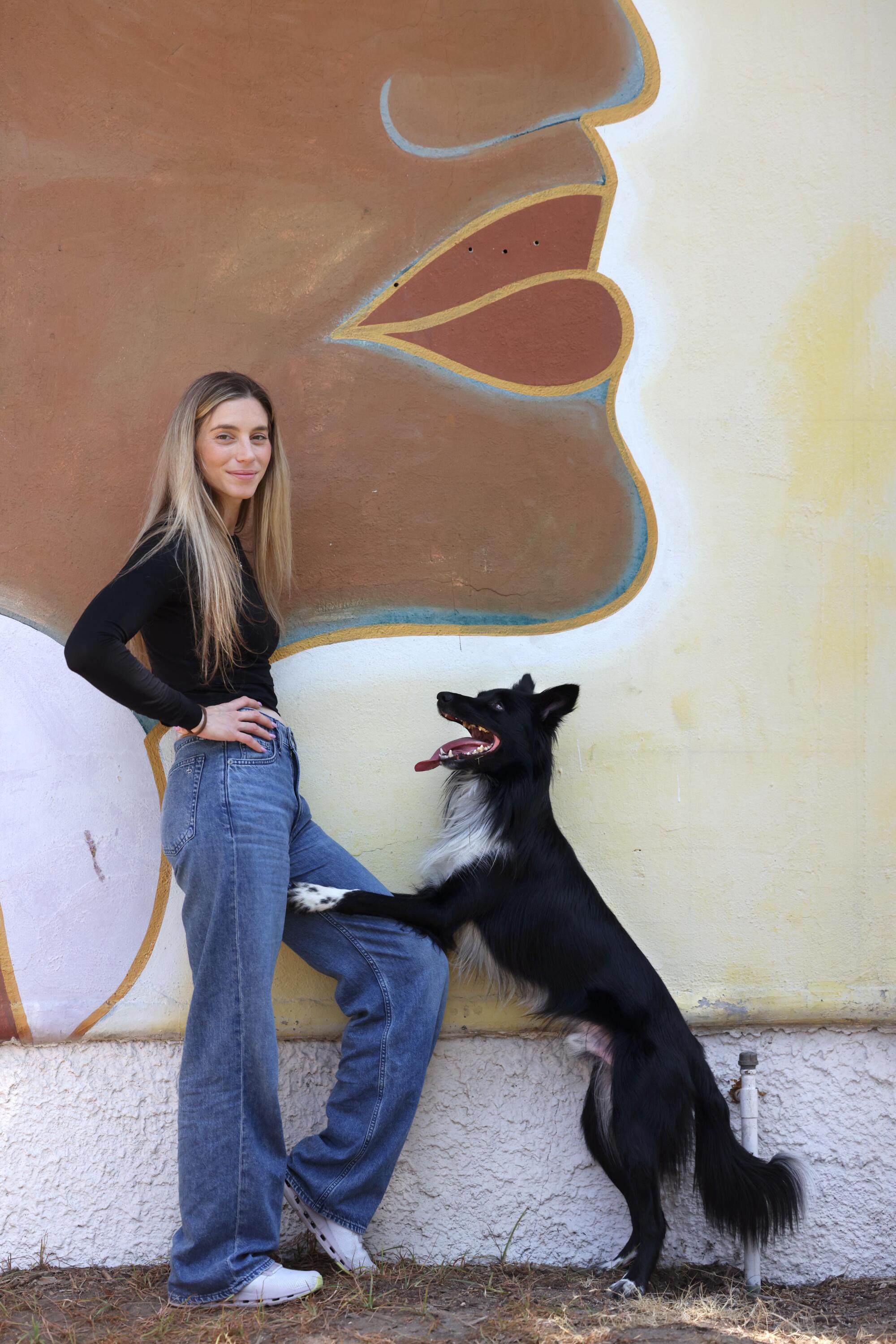
The youngest of her five border collies, Rhythm seemed fated for Sagi. While researching bloodlines on a quest for the ideal canine dance partner, she found via social media the Empire of Fire kennel in Poland, whose border collies matched her specifications.
Just weeks after his birth, Rhythm was already displaying evidence of a natural aptitude for dance in videos Sagi received from the breeder — lying on a bed while tapping and crossing his paws, and also walking backward. After the then-6-week-old puppy passed a socialization test, which evaluates various traits, including temperament, sociability and drive, Sagi finally had her dream dance partner.
Rhythm (whose full name is Rhythm Makes My Heart Go Wow) began his training when he was 5 months old, and he was so fast that Sagi nicknamed him the “black tornado.”
Initially, she encountered skepticism from those who doubted a dog’s capacity to move like a human.
“When I said that Rhythm is going to perform like a dancer, they said, ‘He’s a dog.’ I said, ‘Yes, but I’m aiming for him to look like a dancer when we perform.’ And people told me [doubtfully], ‘We will see.’ And, yes, he’s a dancer.”
Given the incredible impact he has made on “America’s Got Talent,” it is astounding that it’s only Rhythm’s second professional competition. What’s more, unlike the world of dog dance competitions, where participants typically repeat the same routine over the course of a year, Sagi must devise and teach Rhythm an entirely new dance for each performance on the program.
Sagi chooses music that suits Rhythm tempo-wise, building the choreography around him, and then chooses complementary moves for herself. She trains him for one hour per day, using Hebrew and English commands, and food and toys for reward and motivation.
The biggest challenge, she notes, is timing her commands precisely. “What makes it so hard is that I have to say commands offbeat to Rhythm so that every move will go with the music,” Sagi says.
At the end of the day, though, what is most important to Sagi is that Rhythm has a good time.
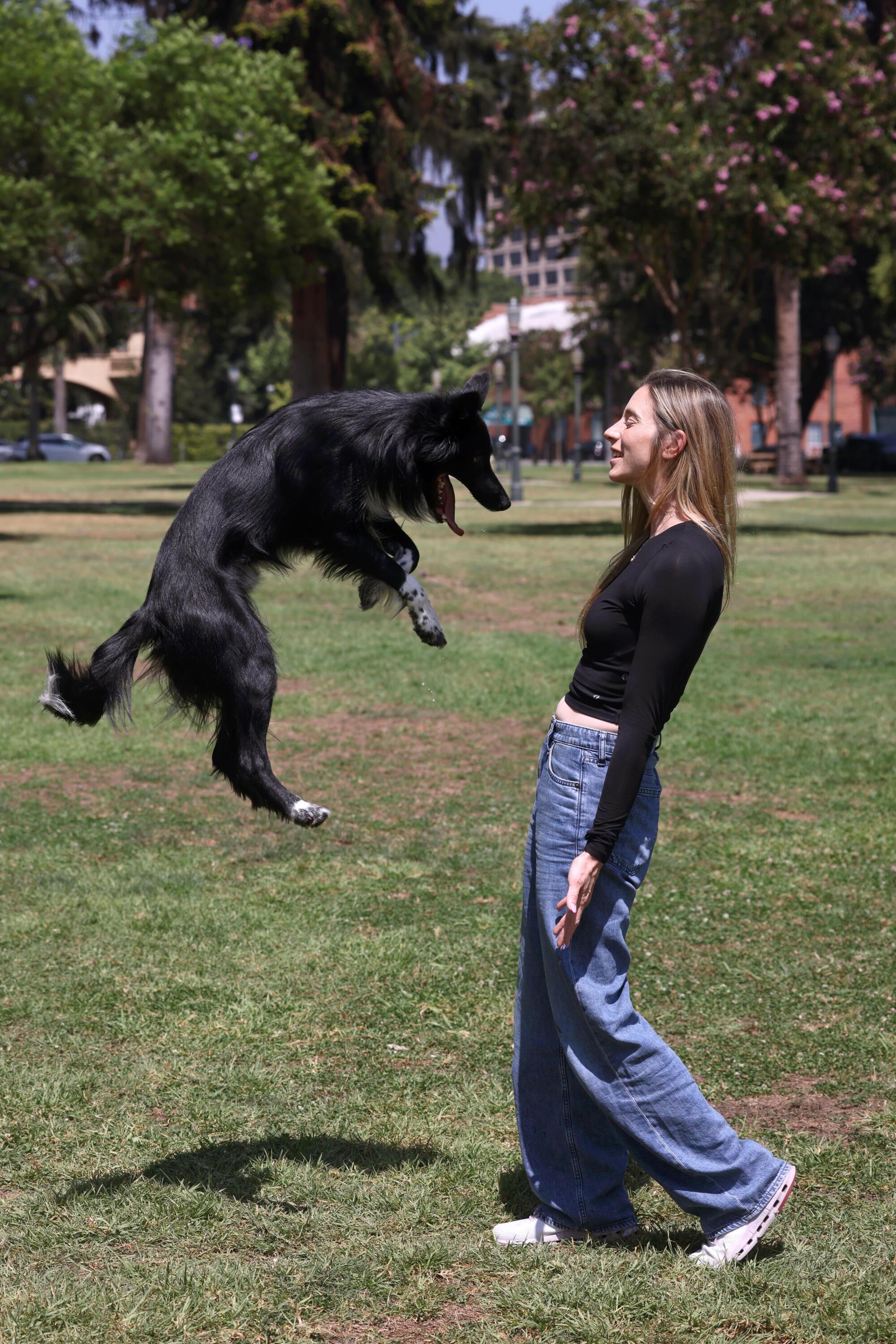
“I don’t want him ever to feel like he’s doing something because I’m forcing him,” she says. “If he’s not having fun training, he will not have fun performing, and it’s important for me that when he goes onstage, he enjoys it.”
In the meantime, although she is thrilled about their continued success on “America’s Got Talent,” she adds that it is hard not to feel like she is living in a bubble while a painful reality exists back home due to the Israel-Hamas war in the Gaza Strip. Wearing a yellow ribbon in her hair, the symbol used by the charity organization Bring Them Home Now, she dedicated her semifinals performance to the hostages taken by Hamas-led militants during the Oct. 7 terrorist attack on Israel.
As difficult as it is to be away from home, however, it was the terrorist attack that motivated Sagi to audition for “America’s Got Talent.” Waking up that morning at her home in Kvar Sava, 25 minutes from Tel Aviv, she was shaken to her core and began to contemplate her mortality: “I became very emotional, and I started thinking, ‘What happens if I die tomorrow? What is my legacy that will stay after me?’
“I realized that I wanted to show the magic of dogs,” she said. ”I don’t have much that I can give to the world, but I have something that inspires people. Dancing with my dog makes people smile and feel happy, so I wanted to share that.”
Still, Sagi also feels guilty being away from her father, unable to help care for him at the moment. In May, he was in an accident on his motorized bike that left him lying on the road unconscious, despite his protective helmet. When he awoke at the hospital several days later, his memory was gone, with no awareness of his own identity or his family. When Sagi contacts him via FaceTime, there is still no recognition of her.
“We are hoping for the best for his recovery,” Sagi says. “It’s hard… but I know that he wants me to be here. He was excited about me going to the show, and he was waiting to watch me audition.”
She finds comfort in the presence of her sister, who flew in to support her.
“I feel so much pride in my little sister and am so happy for her to get the recognition she deserves,” said Sol.
Meanwhile, Sagi heads into the “America’s Got Talent” finals with Rhythm on Sept. 17, hoping for victory. The winner, voted online by the general public, will be announced on the show’s September 24 finale. Regardless of the outcome, Sagi says her extraordinary experience on the show has made her realize that there is no limit to what she and Rhythm can accomplish together.
“I feel so happy and blessed,” she says. “It’s the first time in my life that I don’t feel something is missing.”
More to Read
The biggest entertainment stories
Get our big stories about Hollywood, film, television, music, arts, culture and more right in your inbox as soon as they publish.
You may occasionally receive promotional content from the Los Angeles Times.



